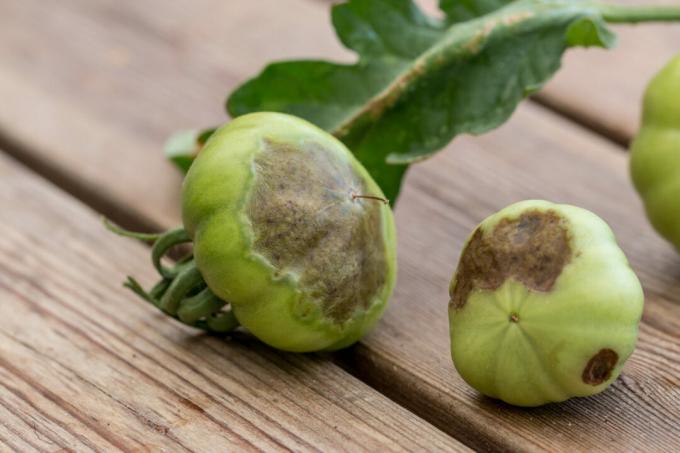If your tomatoes have brown and rotten spots on the ends, it's usually blossom end rot, which is caused by a lack of nutrients.
If your tomatoes (Solanum lycopersicum) develop brown, enlarging spots on the ends of the fruit, you are dealing with tomato blossom end rot. In our expert interview with Floragard you have already learned a lot about this nutrient deficiency. Here is some additional information on tomato blossom end rot.
contents
- Identify blossom end rot
- Blossom end rot and its cause
- Prevent and combat blossom end rot
- Can you still eat tomatoes with blossom end rot?
Identify blossom end rot
Typical symptoms of blossom end rot are the brown or black dots on the tomato. This means that rotten spots form just opposite the fruit stalk. These dots get bigger and look watery. Are particularly affected tomato varieties, which produce very large fruits. These include a wide variety of beefsteak tomatoes or ox hearts. Yellowish discolouration can also sometimes be seen on the leaves.
The affected areas on the tomatoes also collapse, dry later and become hard. Starting from the tips, the whole tomatoes eventually turn black. Especially in the months of June, July and August you have to be careful and keep an eye on the tomatoes. Because if nothing is done about blossom end rot, the fruit will fall off. Blossom end rot can also occur in rare cases
paprika (capsicum) and zucchini (Curcurbita pepo subsp. Pepo convar. giromntiina) occur and shows the same symptoms as in tomatoes.
Blossom end rot and its cause
The cause of this physiological disorder in the tomatoes can be a lack of calcium or often excessive humidity. Due to this calcium deficiency, the cell walls contain too little calcium and the cell walls are therefore not stable. The cell walls then collapse, the affected tissue dies and eventually turns brown.
On the one hand, calcium deficiency can arise when there is too little calcium in your soil, but an imbalance in other nutrients can also cause calcium deficiency. For example, high levels of potassium or magnesium can impede calcium absorption. If there is little calcium in the soil, this also goes hand in hand with a lower pH value. Soil that is too acidic can be brought back into the neutral pH range with liming.
Prevent and combat blossom end rot
One way to prevent blossom end rot in your tomatoes is to keep humidity levels low to encourage transpiration. This is especially important if you are growing your tomatoes in a greenhouse. Since calcium is transported with the water flow in the plants, transpiration ensures that the calcium is transported upwards quickly. You should also ensure an even water supply.
Humidity can also be reduced by increasing air circulation. The circulation can be improved if the stand is not too dense. In this way you promote the transpiration of the individual parts of the plant and reduce the humidity and can thus prevent blossom end rot.
You can also use a fertilizer containing calcium as a preventive measure. Here you will find more information on the right one Fertilization of tomatoes. In solid form, you can use algae lime or rock powder to prevent and combat algae. Just sprinkle it around the tomatoes and pour gently. However, liming can often result in a lack of other nutrients, such as iron, because the pH value changes as a result of liming. You can also introduce calcium in liquid form with calcareous irrigation water or liquid tomato fertilizer use that contain calcium.

Can you still eat tomatoes with blossom end rot?
Since blossom end rot is not caused by bacteria or fungi, you can eat these tomatoes with a clear conscience. All you have to do is cut out the discolored areas if they aren't too big and use the tomatoes as normal. However, be careful when using these tomatoes. Because the affected areas are entry points for fungi and bacteria and can make the tomatoes inedible.
The cut off parts or badly affected tomatoes can simply be composted - so they still serve a purpose. Why each of us one compost should have, find out here. In general, it is better to remove the affected tomatoes from the plant, fertilize them sufficiently and give them the strength to grow many more perfect tomatoes.
tip: A suitable supply of nutrients is important for healthy tomatoes. It is therefore best to use a high-quality vegetable soil such as our peat-free soil when planting Plantura organic tomato & vegetable soil.


